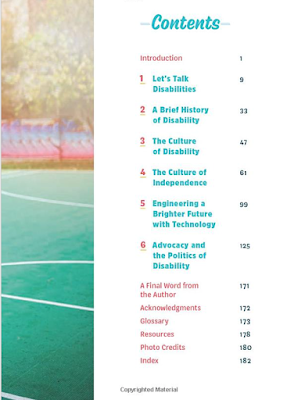Using the word disabled makes me uncomfortable. I think it tends to make us focus on what someone can’t do, rather than what they can. Still, it’s the word used by the author of this book, and I don’t have another one I'm comfortable with, so I’ll continue using it here.
While I am not disabled, I grew up in a family with a disabled person. My father, at 26 years old, was injured in a logging accident. He used a wheelchair from then on. This was well before the world was accessible for people like him. Many years later my mother had a fall that left her with a traumatic brain injury. Even in 2010, the world of medicine and society lacked understanding and acceptance of this kind of invisible disability.
I appreciate that this book exists. It’s full of important content that looks at multiple aspects of what it means to be ‘other.’
I especially appreciate that the layout includes plenty of nonfiction text features. The table of contents provides an overview of the different aspects of disability explored.
Captioned photographs, detailed drawings, facts in extra large print, labeled diagrams, lists, maps, and the use of bold colourful headings and subheadings support the accessibility of this information. The back matter contains a glossary, resources list, and index.
I really liked the yellow framed ‘In Real Life’ inserts that highlight an individual with issues connected to the topic at hand.
My only quibble is that the content focuses primarily on the North American countries of Canada and the United States. The history of disability is limited to Western experiences. In her notes the author states that researching this aspect of the book was traumatic. I get it, it’s hard stuff to take in. I still wish it had explored how disability was dealt with historically in other parts of the world. I would also have liked to have seen a chapter about the role of cultural differences in how people with disabilities are perceived. Perhaps that's for another book
That said, this book is a brilliant introduction to what it means to live life with a disability. As Leavitt asserted, otherness that stems from disability is complicated and multifaceted. This book mentions many different ways to be disabled, but essentially focuses on sensory and physical aspects. Still, I think it provides a good starting point for research and conversations about what it means to be other.
I really liked the yellow framed ‘In Real Life’ inserts that highlight an individual with issues connected to the topic at hand.
My only quibble is that the content focuses primarily on the North American countries of Canada and the United States. The history of disability is limited to Western experiences. In her notes the author states that researching this aspect of the book was traumatic. I get it, it’s hard stuff to take in. I still wish it had explored how disability was dealt with historically in other parts of the world. I would also have liked to have seen a chapter about the role of cultural differences in how people with disabilities are perceived. Perhaps that's for another book
That said, this book is a brilliant introduction to what it means to live life with a disability. As Leavitt asserted, otherness that stems from disability is complicated and multifaceted. This book mentions many different ways to be disabled, but essentially focuses on sensory and physical aspects. Still, I think it provides a good starting point for research and conversations about what it means to be other.
Hopefully readers will be challenged to see diversity rather than disability.


Reading about your personal experiences with disability resonated deeply with me. It's a reminder of the complexities and challenges individuals and families face daily. The importance of understanding and acceptance cannot be overstated. In the realm of employment, connecting with a disability employment service provider can be transformative. They offer invaluable support and resources, helping individuals navigate the workforce with dignity and empowerment.
ReplyDelete